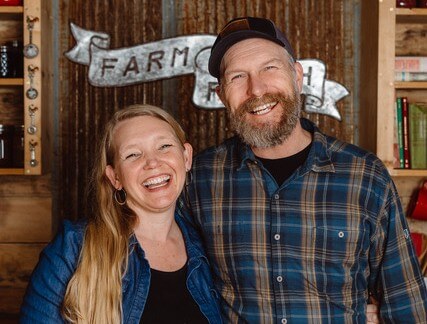Learn the difference between apparel manufacturing in the USA and those from other countries and discover why buying USA-made apparel is so important.

Why Buying USA-Made Products Matters to Us
For the past decade, Josh and I have been trying to buy more made in the USA products. This includes buying for ourselves and Mother’s Day gifts, Father’s Day gifts, birthday gifts or Christmas gifts.
If you missed our podcast on the topic, I highly recommend checking out that blog post. It includes links to many of the American-made brands we love and use ourselves.
A couple of years ago, we watched a documentary called The True Cost, which opened our eyes and changed how we felt about buying clothing that wasn’t manufactured in the USA. If you haven’t watched that documentary, I encourage you to do so (but I wouldn’t recommend watching it with little children around).
There’s a concept called “fast fashion” that Joe discusses in this podcast interview. It’s essentially buying clothing because it’s cheap or because we like the look of it. There’s usually some impulse behind the decision. It’s right here, we like it, it’s inexpensive, and we want it, so we buy it.
To be honest, “fast fashion” is something I notice is a struggle, even with my goal of shopping from made-in-America brands. I am now trying my best to focus more on whether or not I need a specific article of clothing. Then, if I need it, I focus on products made in the USA and their quality. If a product seems more expensive than I anticipated, I discipline myself to wait and save up until I have enough money to buy it, knowing the quality will outweigh the cost.
Josh and I have learned this by switching to American-made apparel. We know we can buy one American-made pair of jeans that will last a couple of years versus buying a cheap pair of jeans manufactured overseas that will fall apart in a matter of months. We put our clothes to the test here on the homestead, so they really do need to hold up!
We also consider affordable clothing for our children. Most people like to save money on children’s clothing because they grow out of it so quickly. Thankfully, we have plenty of children for hand-me-downs, so we try to purchase higher-quality clothing, knowing that items will be passed down from child to child and still be in great shape.

About Joe & USA Brands
Joe Van Deman is the CEO of USA Brands, a company dedicated to preserving and revitalizing American-made apparel and soft goods.
Joe’s vision for USA Brands is deeply rooted in the principles of slow fashion and sustainable manufacturing. He strongly advocates for domestic production, focusing on the importance of American jobs, craftsmanship, and maintaining a rich manufacturing tradition in the United States.
Joe also ensures that his company remains up-to-date with the latest trends; he balances respect for timeless designs with an understanding of market demands, integrating fresh approaches into his brands to keep them relevant and competitive.
With USA Brands, Joe wanted to help ensure the survival of mom-and-pop stores by reaching a larger audience. They now have four major retailers, including Vermont Flannel, All-American Clothing, Gusset and Vermont Teddy Bear. Use coupon code “HOMESTEADINGFAMILY” for free shipping within the USA on purchases of $100 or more (one use per customer, cannot be combined with other offers, expires 12/31/24).

The Decline of Apparel Quality
Something Joe mentioned that resonated with me is that fifty years ago, a nice, expensive suit cost $100. Now, we can order a suit from overseas that looks identical to a really expensive USA-made option for $100, whereas the American-made option costs upwards of $300+.
So, how has the cost of that suit made overseas not increased in price as inflation has gone up? The labor costs and materials used in these offshore manufacturing companies are much cheaper than in the United States.
Instead of a 100% organic cotton USA-made suit, the suit made overseas is a blend of cotton and polyester, rayon, spandex or several other cheaper, lower-quality textiles, reducing the overall cost (and quality).
So we’re not actually comparing apples to apples here. The true comparison would be a 100% cotton, USA-made suit made fifty years ago, which sold for $100, to a 100% cotton, USA-made suit made today, which sells for $300+.
On the one hand, it may seem very expensive. However, you and I both know that a well-made suit can last for decades, whereas the “equivalent” suit made overseas from cheaper materials will likely need to be replaced within a year of wearing. In the long run, both Josh and I have found that buying the more expensive option the first time does save money.

USA vs. Overseas Manufacturing
Over the past few decades, overseas manufacturers have taken advantage of what Joe calls vertical integration. This is where multiple manufacturers have come together to co-locate the various processes needed to make a product. This makes it more convenient and affordable to produce these products.
For comparison, wool produced in the United States first needs to be raised and harvested. It’s then sent to a factory that can turn it into thread. Next, it’s dyed. Finally, it’s weaved into the final product.
So, to transform something grown or raised in the United States into a usable garment, four or five steps are involved. Furthermore, these factories can be located across the country from one another. This doesn’t help reduce the carbon footprint of the product we’re buying, and it certainly doesn’t help reduce the cost.
If companies in America could implement the strategy of co-locating these processes, they could reduce costs and reduce the carbon footprint of the products.

How to Strengthen the “Made in the USA” Movement
I asked Joe what he thought could be done by consumers to strengthen the Made in the USA movement. Josh and I are currently voting with our dollars by choosing to support as many USA-made companies as we can. Here are a few other ideas:
- Consume Less – Joe mentioned that he believes Americans are simply too consumer-driven, and we buy way more products than we need. It’s not often someone in the apparel business encourages people to buy fewer products. But he hopes that by selling a higher-quality product, people will need to purchase them less often, word will get out about how incredible these products are, and more and more people will support those businesses.
- Avoid Fast Fashion – This is something Joe recommends we avoid at all costs. It’s what’s contributing to the 80+ pounds of clothing the average American throws away each year. Fast fashion is that split-second decision to purchase an item because we see it and want it now. With the ease of purchasing through companies like Amazon, we’ve become accustomed to the click of a few buttons, and the product arrives on our doorstep the very next day (or, in some cases, the same day). Taking time to consider whether we truly need an item rather than simply wanting it based on desire will help many of us avoid those costly impulse buys.
- Vote With Your Dollars – Voting with your dollars is the best way to help support American-made products. However, if you’re reading this and you don’t live in the United States, consider looking into companies in your own country that you can support.
- Shop USA Brands – As a reminder, Vermont Flannel, All-American Clothing, Gusset and Vermont Teddy Bear are companies under the umbrella of USA Brands. Start your shopping journey with these companies, and you’ll be off to a great start. Use coupon code “HOMESTEADINGFAMILY” for free shipping within the USA on purchases of $100 or more (one use per customer, cannot be combined with other offers, expires 12/31/24).
We also recommend revisiting our Made in the USA blog post, which features some of our favorite USA-made companies.



















